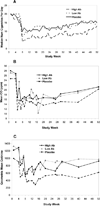Immunogenicity and smoking-cessation outcomes for a novel nicotine immunotherapeutic
- PMID: 21270788
- PMCID: PMC4106715
- DOI: 10.1038/clpt.2010.317
Immunogenicity and smoking-cessation outcomes for a novel nicotine immunotherapeutic
Abstract
NicVAX, a nicotine vaccine (3'AmNic-rEPA), has been clinically evaluated to determine whether higher antibody (Ab) concentrations are associated with higher smoking abstinence rates and whether dosages and frequency of administration are associated with increased Ab response. This randomized, double-blinded, placebo-controlled multicenter clinical trial (N = 301 smokers) tested the results of 200- and 400-µg doses administered four or five times over a period of 6 months, as compared with placebo. 3'AmNic-rEPA recipients with the highest serum antinicotine Ab response (top 30% by area under the curve (AUC)) were significantly more likely than the placebo recipients (24.6% vs. 12.0%, P = 0.024, odds ratio (OR) = 2.69, 95% confidence interval (CI), 1.14-6.37) to attain 8 weeks of continuous abstinence from weeks 19 through 26. The five-injection, 400-µg dose regimen elicited the greatest Ab response and resulted in significantly higher abstinence rates than placebo. This study demonstrates, as proof of concept, that 3'AmNic-rEPA elicits Abs to nicotine and is associated with higher continuous abstinence rates (CAR). Its further development as a treatment for nicotine dependence is therefore justified.
Trial registration: ClinicalTrials.gov NCT00318383 NCT00598325.
Conflict of interest statement
Ms. Akhavain, and Drs. Fahim, Kessler, Kalnik and Niknian are employees of Nabi Biopharmaceuticals and have received salary support, stock and options. All other authors were investigators on the clinical trial funded by NIDA and by Nabi Biopharmaceuticals and some served on an advisory panel. Other disclosures include the following: Dr. Douglas Jorenby has received research support from Pfizer. Dr. David Gonzales has received grant/research support from Pfizer, Addex Pharmaceuticals, Sanofi-Aventis and GlaxoSmithKline; consulting fees and honoraria from Pfizer, GlaxoSmithKline, and Evotech NeuroSciences; speakers fees from Pfizer; and owning five shares of Pfizer stock. Dr. Nancy Rigotti has received research grant support from Pfizer and is an unpaid consultant to Pfizer and Free & Clear. Dr. Elbert Glover has served as a speaker, consultant, grantee, provided advice or is on the advisory board/panel for Pfizer and served as a speaker for Nabi Biopharmaceuticals.
Figures





References
-
- Mackay J, Ericksen M, Shafey O. The Tobacco Atlas. 2nd ed. Atlanta, GA: American Cancer Society; 2006.
-
- Fiore MC, et al. Treating tobacco use and dependence: 2008 update. Rockville, MD: U.S. Department of Health and Human Services. Public Health Service; 2008.
-
- Pentel PR, et al. A nicotine conjugate vaccine reduces nicotine distribution to brain and attenuates its behavioral and cardiovascular effects in rats. Pharmacol. Biochem. Behav. 2000;65:191–198. - PubMed
-
- Carrera MR, et al. Investigations using immunization to attenuate the psychoactive effects of nicotine. Bioorg. Med. Chem. 2004;12:563–570. - PubMed
Publication types
MeSH terms
Substances
Associated data
Grants and funding
LinkOut - more resources
Full Text Sources
Other Literature Sources
Medical

